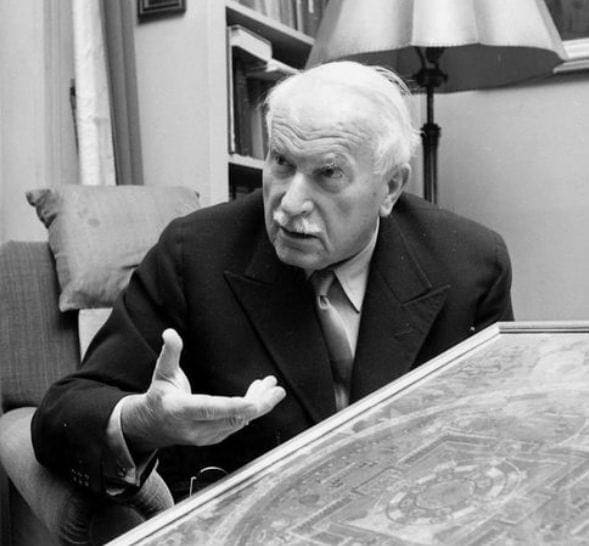
In Jungian Ego and Persona, the collective unconscious and the archetypes are the cornerstones of C.G. Jung’s psychology.
Carl Gustav Jung identified four primary archetypes: the Persona, the Shadow, the Anima/Animus, and the Self.
In this article we describe the interplay between the Ego and the Persona.
The Ego in the Jungian Psychology
The Ego one of the central concepts in jungian psychology. It’s the centre of our consciousness trough which we define ouerselves as individuals using the terms “I” or “Me”. It represents our sense of identity, that we still feel ourselves at 70 to be exactly the same person we were at 7.
The Ego complex emerges out of the Self in the course of the early childhood. The process resembles the separation of the moon from the earth when the latter was in its early stage. The Ego remains linked to the Self by, what Jung have called, the Ego-Self axis. The stability of the personality depends on this axis.
Ego-Consciousness
Jung never made a clear distinction between the terms “Ego” and “Consciousness”, using them interchangeably and sometimes together as “Ego-Consciousness”.
“Although we experience the ego as the continuing centre of our existence it is, in fact, merely the executive of the Self. Our consciousness does not create itself – it wells up from unknown depths. In childhood it awakens gradually, and all through life it wakes each morning out of the depths of sleep from an unconscious condition. It is like a child that is born daily out of the primordial womb of the unconscious”(CWXI, para. 391)
Again and again, Jung stresses the dependency of Ego-Consciousness on the continuing vitality of the Self:
“The ego stands to the self as the moved to the mover, or as object to subject, because the determining factors which radiate out from the self surround the ego on all sides and are therefore superordinate to it, the self, like the unconscious, is an a priori existent out of which the ego evolves“CWXI, para. 391
Persona, the Conformity Archetype

The concept of the persona is Jung’s significant contribution of Analytical Psychology.
Jung coined the term “Persona,” referring to the masks used in the ancient Greek theater. Such masks worn by actors exaggerated facial features, helping convey emotions. In the large outdoor theaters, the masks made it easier for the audience to see and understand expressions, even from a distance. In the same way, Jungian Ego and Persona represent the roles we play in daily life. The ego and persona in Jungian psychology illustrate how individuals balance their inner identity with the outer mask they present to society.
Persona is like a façade of a building. Through the persona we codify ourselves in a form which we hope will prove acceptable to others and ourselves.
Forming a Persona
The persona begins to form in early childhood. Building a persona is a process of integrating acceptable traits into the personality. Children conform to the wishes and expectations of parents, peers, and teachers, quickly learning that certain attitudes and behaviours are rewarded with approval. On the other hand, unacceptable behaviours often result in punishment or the withdrawal of love. The socially undesirable aspects are relegated to the personal unconscious, forming the shadow complex. The persona is the mostly conscious, or easily accessible, side of our psyche. For those asking what is ego and persona in C.G. Jung psychology, it refers to the balance between the outward mask and the inner self. The meaning of persona archetypes in C.G. Jung psychology lies in their role as symbolic patterns that shape identity, social behaviour, and the relationship between self and society.
Psychoanalytically, Persona is situated between the Ego and the Super-Ego and is strongly identity-forming. Persona is the result of identification, internalization, introjection, but also of observational learning and conscious imitation. Its development unfolds dramatically during puberty. However, even later, throughout life, persona undergoes changes.
Positive and Negative Aspects of the Persona
Persona has both positive and negative sides. The protective function of persona gards the ego coherence against excessive hurt, shame, or threat. A well-developed persona supports self-esteem and allows a sovereign social interactions. The confidence-enhancing effect of persona is apparent, for example, in wearing uniforms or academic titles.
However, the uncritical adoption of persona without self-reflection can lead to a neurosis. Often, this strong identification is defensively developed to primarily fend off underlying existential uncertainties. Authoritarian or highly ideological groups, like the fashism, offer their persona image to those lacking ego stability, seeking a protective framework.
On the other hand a weak interest in the external world and limited identification with the persona are not without danger. They often lead to a “false life,” where the roles played are far from who one is or wants to be.
The Persona and the Individuation
The persona may stand in opposition to individual’s inherent drive for individuation. Becoming “who we are” may sometimes take a different direction from becoming “what others want you to be,” with conflicts being inevitable. The well-established awareness and the sufficiently developed persona is “a bridge to the world,” necessary in the individuation process.
Ideally, we develop a flexible, adaptable, yet consistent persona in good alignment with ourselves, avoiding radical identification. In the process of individuation, it is sometimes necessary to relinquish previously valued persona aspects, i.e., to detach oneself from collective expectations.
Jung on the Persona:
“It has sometimes been referred to as the “social archetype” or the “conformity archetype”, for on it depends the success of one’s adaptation to society. There is always some element of pretence about the persona, for it is a kind of shop window in which we do display our best wares; … One could say, with a little exaggeration, that the persona is which in reality one is not, but which oneself as well as others think is”CWIX. i, para. 221

DR. GREGOR KOWAL
Dr. Gregor Kowal studied human medicine at the Ruprecht-Karls-University in Heidelberg, Germany, where he also earned his doctoral degree (PhD). He completed his specialization in Psychiatry and Psychotherapy with the Medical Chamber of Koblenz, Germany. In the following years, he held positions as Head of Department and Medical Director in various psychiatric hospitals across Germany. Alongside his clinical responsibilities, he served as a consultant expert for the Federal Court in Frankfurt, providing psychiatric evaluations in legal cases. Since 2011, Dr. Kowal has been working as the Medical Director of CHMC, the Clinic for Psychiatry and Psychotherapy in Dubai, UAE. His specialist training includes extensive expertise in biological psychiatry and psychodynamic psychotherapy.
Read More about Jungian psychology
- Carl Gustav Jung. A Short Biography
- Psychology of Carl Gustav Jung
- The Collective Unconcious
- The Self
- The Individuation
- The Archetyps
- Archetyps. The Redicovered Theory
- The Ego and The Persona
- The Shadow
- The Animus and The Anima
- The Archytypal Neurosis
- Jungian Psychology and the Brain Structure
- Brain Evolution and Psychology
- Synchronicity
- Jungian Dream Analysis
- Freudian and Jungian Models of the Psyche
- What is Psychoanalytical Psychotherapy
- C.G. Jung and Otto Gross
- C.G. Jung Psychological Types
- C.G. Jung’s Word Association Test
- The Spiritual Aspect of the Psyche (Jungian View)


